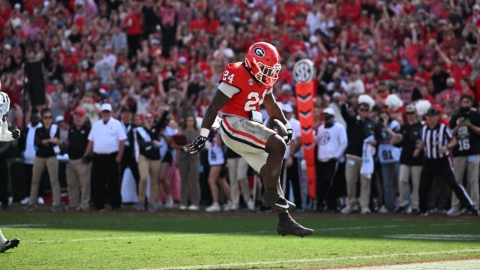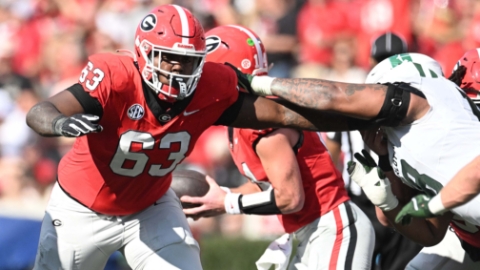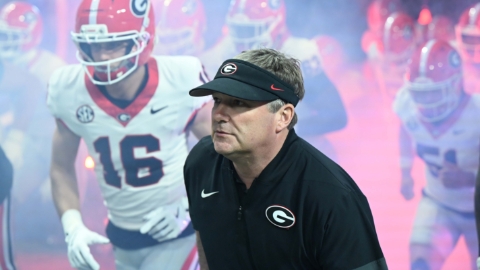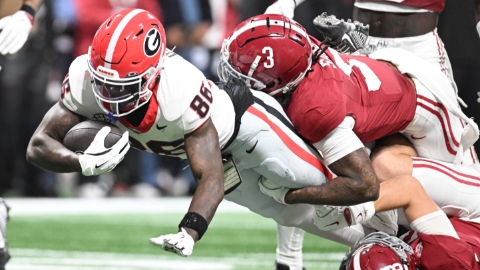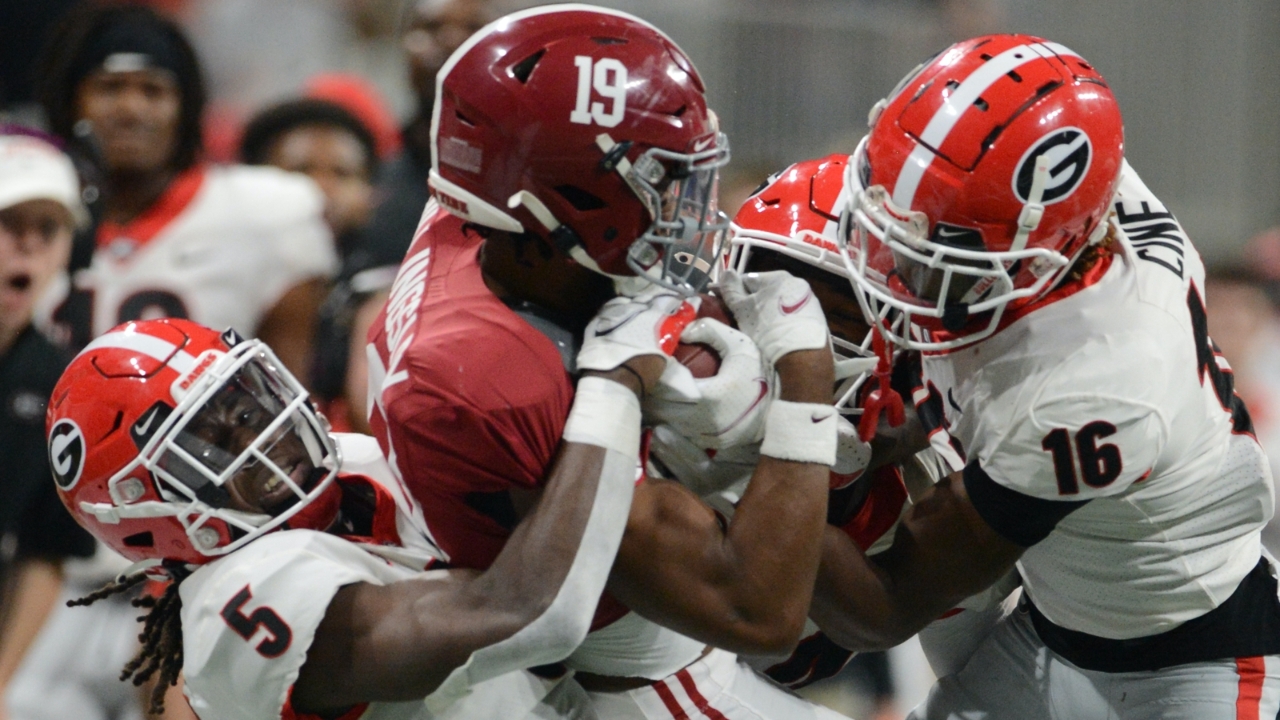
DON’T MISS OUT: Get our insider newsletter today!
ATHENS - Money has never been a problem in college football. Figuring out what to do with it always has been, however, and is more important now.
If you have not noticed, money is being used to recruit players to play college football - and its all above board… at least for now. Navigating this sea change in the sport will be the most critical step for coaches, presidents and institutions.
Somewhere between Clemson’s Dabo Swinney, who continues to fight windmills, and Jackson State’s Deion Sanders lies the new world of recruiting.
$50,000 to play football at an SEC school? I can confirm that is in place. More than $1,000,000 to stay and play football at an SEC school? I can confirm that has happened. A deal worth seven figures for a player to sign with a school? That’s been discussed a lot.
And it’s not like money is being hidden any more. Hell, Tennessee’s Cade Mays has openly discussed needing at least $600,000 to stay instead of leaving for the NFL. More on that later…
All of these things accelerated this summer with the landmark NCAA vs. Alston decision in the Supreme Court.
There are no rules any more - college sports recruiting has very much been deregulated as it relates to money. College football, and sports, is becoming very close to unregulated capitalism. The only thing standing in the way of the schools doing what they want is the NCAA (which is impotent) and state legislatures (which are in bed with the schools as much as anyone).
And that’s just recruiting. The one-time transfer portal has also given the power to the players. As Ole Miss coach Lane Kiffin correctly pointed out:
“The kids a lot of times go to where they're going to get paid the most.”
Bingo.
One does not have to agree with the new world of college sports, or where it is going, to acknowledge its existence. One would be a fool to not adjust.
In other words, schools are going to have to change what they have done in the past in order to win in the future. If coaches and schools insist on chasing pavements in some sort of noble endeavor that never existed in the first place they will fail. In addition, some schools are in prime position to take advantage of recruiting in 2022 - some will be hurt by it.
A new world is here, and the landscape will provide for the most powerful schools, and those with the most advantageous situations to win in very, very big ways.
HOW DID WE GET HERE?
In 1984, Oklahoma, Georgia and Penn State sued the NCAA to have the ability to broadcast more than a couple of football games a year. The schools won, and it changed college football more than any one event in its history.
At the time the NCAA mandated that its members only be shown on TV twice or so a year plus a bowl game - and there were far fewer bowl games at the time. Georgia, for instance, played on national or regional television as often as schools like San Diego State.
When the Supreme Court ruled in favor of the schools that year it was inevitable we would wound up where we are today - with money piling into college football - nation’s second most-popular sport behind only the NFL.
But that did take time - just shy of 40 years.
After the landmark ruling not much changed on the conference side of things. Colleges split up $264 million over four years to broadcast games - about double what TV rights were before in 1981. Still, each home game only secured “about $1 million” according to the New York Times’ reporting in 1981.
Today networks no longer pay for games on a per-contest basis. Now contracts based on agreements with conferences, and are multiyear agreements. The Board of Regents ruling set up that schools could do whatever they wanted in terms of TV. A few years later Notre Dame broke away from the other major NCAA football schools, which had formed something known as the CFA, to partner with NBC in February of 1990. The Los Angeles Times reported that the Irish were paid $10 million a year from 1991-95.
Six months later Arkansas was invited and accepted its invitation to join the SEC. South Carolina followed soon thereafter. An SEC Championship Game was created. The new model of what conferences would look like had been created.
Two divisions, new members and a championship game was the way all major conferences not named the Big 12 developed by 2000. Things were getting more tidy. By late 1989 Penn State joined the Big Ten. The Big East added Miami and football. The new wave of college football had begun, and TV was ready to pay for it powered by ABC, NBC, CBS and ESPN.
The SEC and Big East broke away from the CFA to enter into a long-term agreement with CBS - all but killing off the CFA for good. The contract for the SEC, according to reporting from the Orlando Sentinel in 1994, paid the league and its schools $85 million over five years ($17 million a year).
The money was starting to pour in. Notre Dame got its piece of the pie. The SEC and Big East got their’s as well. Boosters, donors and ticket sales, once the most powerful aspect of an athletic department’s revenue stream, were making way for television contracts.
By 2010 conferences were jumbling around once more, and this time media markets were the No. 1 thing being pursued by broadcasters. Schools like Rutgers (New York City), Texas A&M (Houston), Colorado (Denver) and Maryland (Washington Metro) were being pursued by Power Five conferences as much or more became of how they fit into a media market strategy as their prowess on the field of play.
Selling cable subscriptions on ESPN, the Big Ten Network and other networks was the goal now. Acquiring monthly subscriber revenue in the form of starting your own conference television cable channel had become a major part of revenue expansion for the schools. Money was dumping into athletic departments in the tens of millions each year, and the powers that be in Washington were taking note - as players were not getting compensated and schools were piling up cash.
Criticism of the school’s non-profit status began. Critics also wondered why players were not able to be paid for their efforts. All the while the NCAA was losing power to the conferences it once hovered over. The NCAA basketball tournament, called March Madness, is a billion-dollar event. But even that couldn’t compare to the money and popularity of college football.
Disney and the SEC announced their record-breaking new agreement in late 2020, widely reported to worth more than $3 billion over ten years - and that’s just for the rights to broadcast what CBS has the rights to. SEC schools were more deathly than ever. The deal In jumps member institutions from getting about $55 million a season to $300 million. That makes the SEC’s new deal more valuable for league schools than the NCAA ever has been - and it isn’t close.
And that was before Texas and Oklahoma further consolidated power inside the SEC with their introduction to the league in the summer of 2021. There has never been a conference in collegiate sports as powerful as the SEC is today, which scares the NCAA, Big Ten and others.
The SEC’s power equals money. With the new contract, which not adjusted for the addition of Texas and OU yet, each SEC school will take home just shy of $67 million annually per school. Insiders insist the addition of the Horns and Sooners will drive up that number even higher.
The new TV deal means the SEC is in a commanding space against everyone in college football save, perhaps, the Big Ten. That league currently pulls in $55.6 million per school. The Big 12 averages payout of not more than $42 million per school, but that number will plummet with the loss of OU and Texas. The payout in the ACC is not more than $34 million per school. And the Pac 12 is at about $32 million.
The discrepancy of the media deals puts ACC teams, which share so much geography with the SEC, in a perilous position. For instance: South Carolina, which has struggled to take command of its football rivalry with Clemson for decades, will take in $327 million more than the Tigers over a decade. The same is the case with Dawgs and Jackets, Wildcats and Cards and Noles and Gators.
That reality puts the ACC is in a horrible predicament, and it can’t change the landscape anytime soon. Its agreement with Disney, wh ich bent over backwards to provide that league with a cable channel, doesn’t expire until 2036. Only the addition of new schools can change that deal, and there is no ideal candidate to enter the ACC outside of Notre Dame, which continues to insist on its independence from conference play in football. In addition, Notre Dame being added to the ACC would only move the monetary needle so far as the Irish’s agreement with the league already has Notre Dame playing a slew of away games controlled by the ACC’s media contract.
ich bent over backwards to provide that league with a cable channel, doesn’t expire until 2036. Only the addition of new schools can change that deal, and there is no ideal candidate to enter the ACC outside of Notre Dame, which continues to insist on its independence from conference play in football. In addition, Notre Dame being added to the ACC would only move the monetary needle so far as the Irish’s agreement with the league already has Notre Dame playing a slew of away games controlled by the ACC’s media contract.
The ACC is completely and totally stuck, but in better position than what’s left of the Big 12, which continues to be in shambles. Both leagues and their members are in dire straights as it relates to the future and media revenue.
THE FUTURE IS HERE
Media rights deals are all but ensuring that the SEC will continue to be a or the power broker in college football. Auburn-Alabama, Texas-Oklahoma and Georgia-Florida will form the anchoring of Disney’s SEC coverage over the next decade and beyond. Needless to say, power games like Georgia-Auburn, Georgia-Tennessee, Florida-LSU, Alabama-Tennessee, Auburn-LSU, Texas-Texas A&M, Alabama-LSU and others means the SEC will likely continue being the most-watched league in college football.
In fact, the SEC’s should could grow with its move to ABC and Disney’s ability to promote primetime SEC games on network TV, which has only happened once each year in the current CBS agreement.
The exposure that comes with the new contract means more possibilities for prospects to monetize their name, image and likeness. After all, social media followings are monetizable, but few things deliver audiences like primetime network television… something the SEC has been without for the most part for decades.
The more exposure for the student-athletes or players the more value they have for brands and companies looking to endorse them. Their social media brands and followings will grow as a result of their play on the field.
But schools themselves are also going to be looking for ways to pay players. That can come in any number of ways - but with off-the-books arrangements, or even on-the-books agreements (after new regulations are passes) from the schools to the players themselves.
Big brand sponsors of schools - Delta, Coke, Georgia Power - will look to incorporate their message even further by paying players who are stars. With that said, brands and companies will move foreword like rational actors sooner than later.
As it stands today NIL deals are often not-well-thought-out plans with no guarantee that brands will get any sort of bang for their buck. Likewise, the regulatory environment around the new world of college sports could change noticeably in the coming years at the state and or federal level.
We will have to see.
As it stands today players are considering their options. Former Georgia offensive lineman and current Tennessee Vols Cade Mays said on a podcast last week that he could come back for another year in the SEC… if he could get an NIL deal that would make it worth his while.
“I definitely feel like there could be an NIL deal to supplement what I could make if I went to the NFL. We’re talking about (money comparable to) where I’m projected, so third or fourth-round money.”
Based on the 2021 NFL Draft, that would mean Mays would, at minimum, need to strike an NIL deal worth “about” $600,000. That’s the amount of an NFL contract without a signing bonus.
But that’s not a realistic amount of money for Mays as it relates to his social media following, or his possible impact as an influencer. An offensive lineman that’s not well known on the national level is likely irrelevant for sponsors who have six-figure marketing spends.
Nonetheless, it is important to understand the marketplace of what followers mean. How does one monetize social media? It is common, and some people are very good at it.
Mays has 21,200 followers on twitter. He has another 21,500 followers on Instagram. Different social platforms are valued at different prices, and of course any company could pay any amount at at time if they see value in Mays being associated with their company or cause.
According to Social Bluebook, Mays’ Twitter following is worth less than $132 per tweet. A video from Mays on instagram would be worth about $400; a photo post would be worth about $250; a reel would be worth $125; and a story would be worth about $100.
With that math Mays would have to post 4,545 tweets in a year, or at least 1,500 posts of any sort on Instagram to get $600,000 worth of value for any company or sponsors.
In other words, Mays’ following is simply not worth the value of his value as a third or fourth-round pick. NIL is powerful right now, but it isn’t “that” powerful. Mays getting that sort of money would involve someone willing to pay him and not get the full value for the money in terms of marketing. He would have to get paid, and this is reality, for him starting on the offensive line at Tennessee. And the value for that is harder to quantify. That would be up to whoever wanted to do that deal.
Then again, Mays plays at Tennessee, which is not in a major media market (Knoxville, No. 62 nationally). He once did play in a major media market - Atlanta. Metro Atlanta is the No. 7 media market in the United States. Georgia, unlike so many college football powers, is positioned powerfully in the new landscape of college football.
USC, which just pulled in Lincoln Riley, sits in the No. 2 media market - Los Angeles - but is crippled by the Pac 12’s worst-in-class rights deal. Michigan is a major football power in a major media market - No. 15 Detroit - and Michigan has the power of the Big Ten’s media contract bolstering its position.
Most major media markets - New York, Chicago, Philadelphia, Dallas-Fort Worth, San Fransisco-Oakland, Houston, Washington and Boston - don’t have major powers in their market.
The opportunity for schools like Georgia being positioned in a state where they are the only major power, and have a massive market within an hour drive is rare. Still, schools like Miami (No. 18 market), Colorado (No. 16), Washington (No. 12) who have won national titles in the last 31 years are poised to take advantage of the new world if they can get their acts together. The problem for Colorado and Washington is a lack of quality prospects in their market.
With that said, schools that aren’t in cities, and are not near big markets in their state like Florida State (No. 108), Clemson (No. 35), Oklahoma (No. 44), Nebraska (No. 105) and perhaps even Tennessee (No. 62) are at risk of being passed by over the next decade if they don’t adapt. Nebraska has not found its way in years. Tennessee isn’t that far from that. Clemson’s fanbase is spread out in a small state, with a small population, and that’s not an ideal situation.
Then schools like Florida, Ohio State, Texas and Texas A&M are harder to gauge because they are big schools that have spread out fanbases in very large states. For instance, Florida has long used the so-called Gator Triangle from Jacksonville to Orlando and Tampa as its base. The Gators are the biggest thing in their state, but it is hard to know which town in the state has the “most” Gators - obviously Gainesville, but it isn’t near the size of those three major cities.
The same could be said with Aggies and Horns in Dallas and Houston. Ohio State has the No. 33 media market in the country, which is pretty significant. But it also has No. 19 Cleveland and No. 36 Cincinnati, which has a few Bearcats hovering. Ohio State, like Alabama, has a national brand that is based as much on TV exposure as it is to local markets. Those two are the biggest TV brands in the country. Georgia usually next in line on that front.
WILLING TO PAY UP
The other factor to consider isn’t value of players selling or marketing a product. It is the will of particular fanbases to win, and to do what it takes to win. Wealthy fanbases like Texas, Georgia, Michigan, USC, A&M and the like have shown over time they are willing to travel to watch their teams, and give their programs whatever is needed to win.
But now they will all have to compete with one another on a national level to sell players on picking their school because it is the best fit for finances as well as football. There are already action items being put in motion to streamline this process. At least one SEC school guaranteed a seven-figure deal for a player to not transfer. Another SEC school guaranteed at least one signee $50,000 a year to play for that school (how that was secured is not quite known, but it was not viewed as being against the new rules by the schools themselves; as it was done “in the open”).
Now star players are going to expect to be compensated not just for their work, but for their fame as well. Tim Tebow, Herschel Walker and Johnny Manziel were not able to capitalize on their fame while in school. But today’s stars have been able to do so - and how.
The new future involves school booster clubs loosely associated with the school, say graduates or former players who have formed clubs or businesses not under the umbrella of the school itself that has an express purpose of creating revenue to pay players. This is the model Mays should focus on, but it is in its infancy.
But it will be everywhere soon. This is a race against foes to get the right settlings in place to position for the new future of college football. And everything matters - all of the money matters. All of it. Because money is power in college sports. It has given schools the ability to pretty well kick the NCAA to the curb… it remains to be seen if the NCAA will exist in its current form in a decade.
Insiders admit - sometimes not so bashfully - that the SEC specifically, but the conferences generally are more powerful than the NCAA. What we can’t know is when the gold rush that is NIL will settle down into a reality-based system.
Deals with players like D.J. Uiagalelei and JT Daniels have not worked out because those two are either not playing, or not at all playing the way their NIL deals would have suspected this past summer. Most insiders think that part of things will settle down, and that irrational spending on players will not continue.
But we can’t know that like we can’t know what the regulatory landscape will be. Then again, lawmakers might not be able to stomach putting restrictions on the earnings of players when so-called non-profit institutions are pulling in billions, and making more than that for their corporate partners.
Time will tell, but fighting the future is useless. The future is here, and has been on the way for a long, long time.
*DawgPost.com has teamed up with Fanatics to connect our readers with the best selection of officially licensed UGA fan gear out there. If you purchase through our links, we will earn a commission that will support the work we do on this site.





